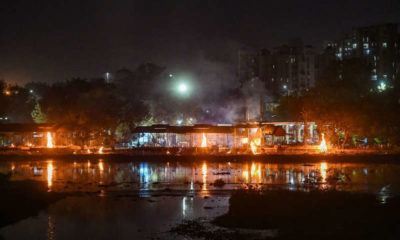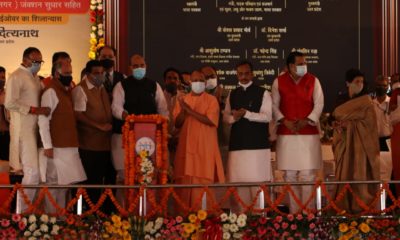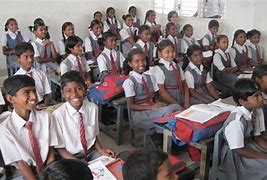Feature
UP Divas special read how Uttar Pradesh state got its name

Lucknow: The Uttar Pradesh government today celebrated for the first time the state’s foundation day, the day when the erstwhile United Provinces was rechristened Uttar Pradesh in 1950, but very few people know how the state got its name.
The idea to mark UP Divas stemmed from a suggestion by Governor Ram Naik, who proposed to celebrate the day on the lines of Maharashtra Day so that people know the history and culture of their state.
Pushing for the state celebrating its foundation day like many other states, Naik had some time ago said, “I am sure all north Indians living abroad will begin celebrating Uttar Pradesh Divas as they celebrate Ram Navmi and Janmasthmi.”
Till now, a large number of people in the state may have remained unaware of its foundation day in view of its long history, which can be traced back to ancient times.
The state was called the Brahmrishi Desh or the Madhya Desh in the Vedic period. During the Mughal period, its territory was divided under governors.
The details of the various transitions – from change of its capitals to the time it got its final name – are available at the UP State Archives.
History says Uttar Pradesh came into existence on January 24, 1950, when the governor-general of India passed United Provinces (Alteration of Name) Order 1950, renaming United Provinces as Uttar Pradesh. The governor general’s order was published in the Uttar Pradesh Gazette (Extraordinary) dated January 24, 1950.
Uttar Pradesh has witnessed various changes over the years. It reached its present size after the hill state of Uttarakhand was carved out of the undivided UP on November 9, 2000.
But, very few know the history of how the name Uttar Pradesh was decided upon.
According to the books on UP and documents at the archives, the state was under the Bengal Presidency till 1834.
But then the need to form a fourth presidency was felt, the three being Bengal, Bombay and Madras. The fourth presidency was known as the Agra Presidency that was headed by a governor.
In 1836, this presidency came under the lieutenant governor.
In January 1858, Lord Canning proceeded to Allahabad and formed the North Western Province, excluding the Delhi division. The seat of power was thus shifted from Agra to Allahabad. This was followed by the transfer of the high court from Agra to Allahabad in 1868.
In 1856, Awadh was placed under the chief commissioner.
The districts were later merged with North Western Province and came to be know as ‘North Western Provinces and Oudh’ in 1877. The entire province in 1902 came to be known as the ‘United Provinces of Agra and Oudh’.
On foundation day of Uttar Pradesh know how ‘State’ got its name:
The first election was held in 1920 for legislative council, which was constituted in Lucknow in 1921. Since the governor, ministers and the secretaries to governor had to be in Lucknow, the then governor Sir Harcount Butler changed his headquarters from Allahabad to Lucknow. By 1935, the entire office was shifted to Lucknow.
Lucknow became the capital of the province, the name of which was again changed to United Province in April 1937.
The name was changed once again to Uttar Pradesh in January, 1950, under the Constitution of India.
An interesting account appears in Gyanesh Kudaisya authored Region, Nation, Heartland: Uttar Pradesh in India’s Body Politic.
The comprehensive account illustrates how seriously the post-Independence leadership in UP considered itself the heartland of the newly-independent country.
Since 1902, the province was known as the United Provinces of Agra and Oudh; which in 1937 was shortened to United Province or UP. Within days of Independence, the UP legislature began debating a “suitable name”.
Nearly 20 names emerged but consensus eluded for long.
In October 1949, the matter could not be postponed further as drafting of the new Constitution was nearing completion and had to include the names of the provinces.
The matter was placed before the Provincial Congress Committee that met at Banaras in November 1949. An overwhelming majority of 106 members supported a motion in favour or ‘Aryavarta’ while ‘Hind’ received 22 votes.
Prominent Congress leader GB Pant conveyed the decision to the Constituent Assembly that shot it down.
Central Province-Berar member RK Sidhwa feared that United Provinces was anxious to monopolise the name of India.
He bluntly charged UP with looking upon itself as the “supermost province of India”.
Finally, then Law Minister Dr BR Ambedkar moved a Bill empowering the Governor-General to alter the names of provinces to the Union.
Pant promised to refrain from suggesting pompous names like ‘Aryavarta’.
Congress members from UP in the Constituent Assembly were asked to work out a compromise on “Uttar Pradesh”, and the rest, as they say, is history.
Entertainment
Meghalaya Reserves Legalized Gambling and Sports Betting for Tourists

The State Scores Extra High on Gaming-Friendly Industry Index
Meghalaya scored 92.85 out of 100 possible points in a Gaming Industry Index and proved to be India’s most gaming-friendly state following its recent profound legislation changes over the field allowing land-based and online gaming, including games of chance, under a licensing regime.
The index by the UK India Business Council (UKIBC) uses a scale of 0 to 100 to measure the level of legalisation on gambling and betting achieved by a state based on the scores over a set of seven different games – lottery, horse racing, betting on sports, poker, rummy, casino and fantasy sports
Starting from February last year, Meghalaya became the third state in India’s northeast to legalise gambling and betting after Sikkim and Nagaland. After consultations with the UKIBC, the state proceeded with the adoption of the Meghalaya Regulation of Gaming Act, 2021 and the nullification of the Meghalaya Prevention of Gambling Act, 1970. Subsequently in December, the Meghalaya Regulation of Gaming Rules, 2021 were notified and came into force.
All for the Tourists
The move to legalise and license various forms of offline and online betting and gambling in Meghalaya is aimed at boosting tourism and creating jobs, and altogether raising taxation revenues for the northeastern state. At the same time, the opportunities to bet and gamble legally will be reserved only for tourists and visitors.
“We came out with a Gaming Act and subsequently framed the Regulation of Gaming Rules, 2021. The government will accordingly issue licenses to operate games of skill and chance, both online and offline,” said James P. K. Sangma, Meghalaya State Law and Taxation Minister speaking in the capital city of Shillong. “But the legalized gambling and gaming will only be for tourists and not residents of Meghalaya,” he continued.
To be allowed to play, tourists and people visiting the state for work or business purposes will have to prove their non-resident status by presenting appropriate documents, in a process similar to a bank KYC (Know Your Customer) procedure.
Meghalaya Reaches Out to a Vast Market
With 140 millions of people in India estimated to bet regularly on sports, and a total of 370 million desi bettors around prominent sporting events, as per data from one of the latest reports by Esse N Videri, Meghalaya is set to reach out and take a piece of a vast market.
Estimates on the financial value of India’s sports betting market, combined across all types of offline channels and online sports and cricket predictions and betting platforms, speak about amounts between $130 and $150 billion (roughly between ₹9.7 and ₹11.5 lakh crore).
Andhra Pradesh, Telangana and Delhi are shown to deliver the highest number of bettors and Meghalaya can count on substantial tourists flow from their betting circles. The sports betting communities of Karnataka, Maharashtra, Uttar Pradesh and Haryana are also not to be underestimated.
Among the sports, cricket is most popular, registering 68 percent of the total bet count analyzed by Esse N Videri. Football takes second position with 11 percent of the bets, followed by betting on FIFA at 7 percent and on eCricket at 5 percent. The last position in the Top 5 of popular sports for betting in India is taken by tennis with 3 percent of the bet count.
Local Citizens will Still have Their Teer Betting
Meghalaya residents will still be permitted to participate in teer betting over arrow-shooting results. Teer is a traditional method of gambling, somewhat similar to a lottery draw, and held under the rules of the Meghalaya Regulation of the Game of Arrow Shooting and the Sale of Teer Tickets Act, 2018.
Teer includes bettors wagering on the number of arrows that reach the target which is placed about 50 meters away from a team of 20 archers positioned in a semicircle.
The archers shoot volleys of arrows at the target for ten minutes, and players place their bets choosing a number between 0 and 99 trying to guess the last two digits of the number of arrows that successfully pierce the target.
If, for example, the number of hits is 256, anyone who has bet on 56 wins an amount eight times bigger than their wager.










































